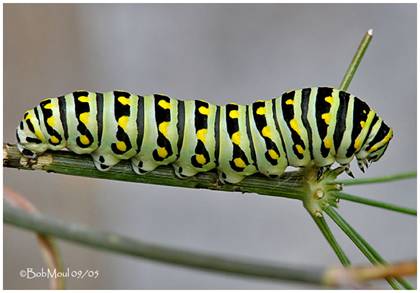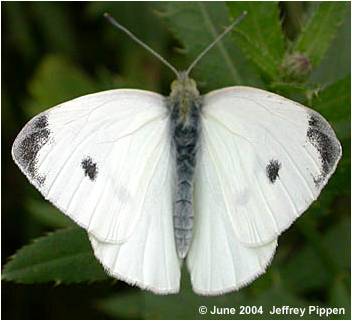Name: Black Swallowtail (Papilionidae Family)

Black Swallowtail caterpillar

Female Black Swallowtail Butterfly

Male Black Swallowtail Butterfly
*All of the above images are sourced fromhttp://www.pbase.com/rcm1840/lifecycleofblsw
Physical Characteristic: Caterpillars are light green in colour with black stripes with yellow markings. The butterflies are black, with yellow and blue marking on their wings.
Diet: The adult butterflies feed on nectar from a variety of flowers, while the caterpillars feed on dill, parsley and fennel, tearing wholes in the leaves
Benefits: cross pollinate when retrieving nectar from various flowers
Other: Creatures of beauty and transformation. Butterflies indicate that the overall health of the garden is good.
Reference: Cranshaw, W. (2004). Garden Insects of North America. Princeton, New Jersey: Princeton Press, pp.168-169.
Name: Monarch Butterfly (Danaus Plexippus)

Monarch Caterpillar (1)

Monarch Butterflies (2)
Image Sources:
(1) http://www.learner.org/jnorth/tm/monarch/LarvaFacts.html
(2)http://www.monarch-butterfly.com/graphics/butterfly30.jpg
Physical Characteristics: The Caterpillars are a combination of yellow, black and white stripes. The adult butterflies are mainly orange with black lines, with white spot markings on the outer potion of their wings.
Diet: Caterpillars feed on milkweed, which helps them to avoid predations as a butterfly. The chemicals from the milkweed plant that they eat when they are a caterpillar builds up inside of them and gives them a poisonous defense against predators like frogs, birds, mice and lizards. Adult butterflies feed on the nectar of any flower, but no longer need to feed on milkweed, as the chemical toxin is already formed in their bodies as their defensive mechanism.
Benefits: These butterflies act as pollinators for the garden.
Other: The monarch butterfly migrates roughly 2500 miles to escape the cold in the wintertime.
Reference:
The King of Butterflies – The Monarch Butterfly (n.d.) Monarch Butterfly Website
http://www.monarch-butterfly.com/monarch-butterflies-facts.hml [Accessed 20 Mar 2013]
Name: The Cabbage White Butterfly (Pieris rapae)

The Cabbage White Caterpillar

The Cabbage white female butterfly

The Cabbage white male butterfly
All of the above images are sourced fromhttp://www.butterfliesandmoths.org/species/Pieris-rapae
Physical Characteristics: Caterpillars are a light green colour. Female butterflies have two spots on their wings while males have one spot on their wings. They have a sister species called the white veined butterfly, which looks identical to the cabbage butterfly minus the black markings.
Diet: They feed on cabbages, broccoli and turnip plants as caterpillars, and nectar when they are adult butterflies.
Benefits: Pollinators for the garden
References: Kulzer, Lousie (1993) Pieris rapae, The Cabbage White Butterfly. Bug of the Month: April 1993 http://crawford.tardigrade.net/bugs/BugofMonth01.html
Name: Snowberry Clearwing Moth (Hermaris diffinis)

The Snowberry Clearwing Caterpillar

The Snowberry Clearwing moth
The Above images are sourced from http://www.butterfliesandmoths.org/species/Hemaris-diffinis
Physical Description: The caterpillar is green, with black dots along its sides. The moth is yellow with black around its midsection and tail, with clear wings with brown near the ends.
Diet: The caterpillars feed on dogbane, honeysuckle and snowberry plants, while the adult moths feed on nectar
Benefits: Adult moths are pollinators
References: Species Hemaris diffinis - Snowberry Clearwing (2004) Bug Guide[Accessed 30 Mar 2013] http://bugguide.net/node/view/2639

